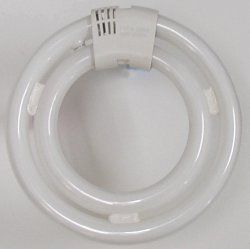This post has been updated from its original 2013 version.
These round bulbs pack a few more features than their fun design suggests, and if you are not savvy to the ways of circline lamps you may have a hard time incorporating them into your home’s lighting. To fully understand and get the best out of circular fluorescent bulbs, keep the following four facts in mind.
Pay Attention to Wattage
Just as with (the soon to be gone) standard incandescent light bulbs, circline lamps use wattages to measure how much power is used to light a bulb. By comparison, the circular fluorescent lights emit the same amount of light (lumens) while using less power than incandescents. A circline light bulb of only 13 watts can replace a 60 watt incandescent bulb and has an output of 650-900 lumens. The wattage of the bulb also determines the diameter of the bulb which in turn determines if it will fit the fixture. So unlike standard spiral CFLs you may not be able to go up or down in wattage range because it will affect the size of the bulb possibly rendering it unusable with your fixture.
Color Temperatures Are the Same as Standard CFLs
Color temperatures represent how bright a bulb is. Circular fluorescent bulbs can range in color from warm white to the brightest daylight just like standard compact fluorescent lights. Color specifics are all varying shades of white:
- 2700K: Warm, equivalent to what is typical in a bedroom or living room
- 3000-3500K: Soft, suitable for bathrooms
- 4100K: Cool, florescent-like in color
- 5000K: Daylight, the brightest color, like sunlight at noon
Circular Bulbs Cannot be Used in Just Any Fixture
This is where using a circular fluorescent can get tricky. Depending on the manufacturer, some light fixtures only use bulbs from their own line. Yeah, I know it can be tempting sometimes to go with an off/generic brand, but in this case your generic circline lamp may not work in the fixture. When replacing a Circular Lamp, first make sure that there are no manufacturer specifics determining what bulb can be used. Next, determine what the lamp type (e.g. T6 , T9) and pin type is (e.g. 2 pin, 4 pin). When finding the right lamp for your fixture, you have to choose the same lamp type and pin types as these are not interchangeable.
Diameter Matters
For light fixtures that use circular bulbs that are too big or too small will not work, even if it is from the right manufacturer. Make sure to replace these bulbs by measuring the diameter of an existing bulb then purchase the right size. If you would rather leave measuring alone, you can also use the manufacturer model number to find a replacement bulb.
While there is more to be taught and learned about circular fluorescent bulbs, these four facts alone will allow you to make informed purchases and hassle-free replacements. See, it doesn’t take much to become savvy to the ways of circline lamps.


Circline bulbs are not CFL’s. CFL bulbs contain their own ballast. That is why they can directly replace an incandescent bulb. Circline bulbs use an external ballast like a straight tube fluorescent. Generally, any fluorescent is about 5 times more efficient than an incandescent.
are they measured from out side or inside diameter?
Hi Charles,
These are measured from the outside.
My circular tube light when turned on at switch stays on a bit, 5minutes or so, then goes off a bit, then comes on a bit, then goes off. Is this normal. What to do?
I bought an 8″ Circline Bulb (22W) to replace dead bulb in bathroom ceiling fixture without taking the old one in (couldn’t remove locking clip in the dark). Turns out the old one is a 9″ 30W Circline Bulb. I installed the 8″ anyway and have it mounted to one clip and the connector (which has an anchor) My question is…. is there any risk in have the slightly smaller bulb up there? It lights right up. Am I ok? Thanks in advance
I bought a 9″ circular bulb (30W) to replace a burnt out one. The new bulb match identifiers codes match the burnt one. I replaced the bulb. the new bulb does not light up around the entire structure. It only lights up about 2 inches from the insertion source. Why? What is happening?
Rhonda says:
I bought a 9″ circular bulb (30W) to replace a burnt out one. The new bulb match identifiers codes match the burnt one. I replaced the bulb. the new bulb does not light up around the entire structure. It only lights up about 2 inches from the insertion source. Why? What is happening?
From your comments you haven’t mentioned replacing the starter as well as the tube and it sounds like the starter needs replacing. As a general rule you should always replace the starter at the same time as replacing the tube or otherwise you will shorten the life of your new tube.
Please explain the model numbers. You say to watch out for things like T9, T6. What is the T number? Tube diameter?
Yes! The T stands for tube or tubular shape of the bulb, and the number behind it specifies the diameter in 1/8″ increments.
can i replace a t6 4 pin with a t9 4 pin of the same diameter
Hi Ron. These lights are generally not interchangeable. The t6 should only be replaced with another t6 bulb.
Never put these in a house you plan to sell. They are weird and horrible. Rip those fixtures out and put in normal lights! Everyone but the weirdos who like these horrid things will thank you!!
Really interesting post!